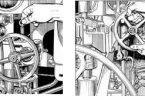- One of the most important considerations to be taken into account when installing echo sounder equipment is the selection of the transducer position. The ideal position is one in which the water is free from aeration beneath the transducer, and where the effects of surface, engine and propeller noise are at a minimum. There are, however, few positions in a ship which are suitable in every respect, also a position found to be satisfactory in one design of ship may not necessarily produce equally good results in another.
- The principal source of aeration is the bow wave created by a moving ship where aerated water is forced beneath the hull. The resultant bubble stream normally starts about a quarter length of the ship from the stem, and divides about three-quarters of the length from the bow. The bubble stream varies in form and intensity according to the speed, draught, shape of bow and hull, and the trim of the ship as well as the sea state. These factors should be taken into account when siting the transducer. In particular, in the case of a ship with a bulbous bow, the only satisfactory forward site may be within the bulb, although the possibility of physical damage has to be recognised.
- To avoid aeration, a position at the forepeak is desirable but it may be unsatisfactory in a ship with a light draught forward, especially in bad weather conditions. In addition, the hull shape may make fitting difficult. In a laden ship of normal design a position within a quarter of the ship’s length from the stem will often be found to give satisfactory results. On small ships damage may occur due to pounding and care should be taken when siting the transducer. An aft position may be more suitable than one forward. Care should be taken, however, to site the receiving transducer a sufficient distance from the propellers to avoid the effects of noise or aeration. When separate transmitting and receiving transducers are fitted, they should be sufficiently separated to prevent interaction between them but the separation should be as small as possible to ensure accurate soundings in shallow water. Positions either side of the keel are sometimes found to be satisfactory.
Other factors which should be borne in mind when fitting transducers are as follows:
- The transducer is best located in a horizontal position. In some cases fitting with a slight projection from the hull will help avoid the effects of aeration at the hull surface. If the transducer projects from the hull it will be necessary to ‘fair off’ this projection.
- If, in exceptional circumstances, a windowed transducer has to be used, the window should be acoustically transparent, so that the range of the equipment will not be adversely affected.
- Siting should be avoided near and particularly aft of obstructions such as a forward propeller, bow thruster, water intake/discharge pipes, drain plugs and external speed measuring devices.
- To minimise the effects of roll and pitch a position near to the centre line should be chosen when practicable.
- When appropriate, care should be taken to minimise interference between echo sounders and Doppler speed devices.
- Information on transducer location should be kept on board with the equipment handbook.
Related Searches:



